Smoke-free Coast: Camp in Murter Swapping Free Drinks for Cigarette Butts
August 4, 2019 - Murter is the latest in the fight to make Croatia's coast free of cigarette pollution.
Earlier this week, TCN reported that the City of Hvar installed biodegradable cardboard ashtrays to reduce the environmental impact of littered cigarette butts on the beaches thanks to a solution by the Volim Vlašići Association from the island of Pag. Recall, the ashtrays are disposable or reusable, made of paper (cardboard), are biodegradable, and have assembly instructions.
Today, we bring you another example of a Croatian town joining the fight against cigarette pollution, reports Dalmacija Danas.
Namely, you might have heard of “Smoke-free coast”, the name of a campaign that delighted locals and tourists in Estepona, a small coastal town in southern Spain. The campaign is straightforward: bring a glass full of cigarette butts to any stall on the beach and in return, enjoy a cold beer or refreshing drink.
The example of Estepona has caught on in Croatia, and the same practice has been adopted by a camp in Murter, who informed locals and tourists in the area via Facebook that they are joining the smoke-free action.
“Following the example of a story from a place in southern Spain where you get a drink in return for a glass full of cigarette butts, we decided to apply the same practice. Camp Slanica, in cooperation with the Lostura beach bar, joins the action - anyone who brings a glass/bottle/bag full of cigarette butts to the beach bar Lostura, gets in return free juice or beer! Since the Murter-Kornati Tourist Board has installed ashtrays on all beaches in Murter at the beginning of summer, you can also freely use cans that serve as ashtrays and fill them with cigarette butts that you find on your favorite beach in Murter. With this action, we all contribute together to a cleaner environment, and at the same time we participate in the prevention of fires, since cigarette butts are a common cause of fires. Hurry up for the action and refresh yourself for the reward - collect, replace, cheers!,” said Camp Slanica on facebook.
NBC News reported that cigarette butts are the single most collected item on the world’s beaches, with more than 60 million collected over 32 years. Not surprisingly, this number amounts to “about one-third of all collected items and more than plastic wrappers, containers, bottle caps, eating utensils and bottles, combined”, NBC said.
Much like plastic, cigarette butts take years to disappear from the environment and the chemicals they are composed of are harmful to everything from plants and wildlife to children.
To read more about lifestyle in Croatia, follow TCN’s dedicated page.
Betina Shipbuilding Museum: Outdoor Exhibition Opened
On Saturday, June 8th, the outdoor exhibition of the Museum of Wooden Shipbuilding was opened. The exhibits of the museum presented to the public in the natural outside ambience testify the highest quality of the traditional wooden shipbuilding, as well as the methods of maintaining, the multiple uses that were designed for the ships, the sailing and the traditional materials. The newly designed outdoors exhibition of the Betina Shipbuilding Museum complements the permanent exhibition of the museum, by placing the objects into their original context. That allows the Betina-made gajeta, leut, pasara and many other boats located at the local port to be interpreted correctly, within their natural environment.
The museum keeps and saves the knowledge and the tradition of the wooden shipbuilding which has always been (and remains) a part of the great Croatian maritime heritage. That heritage is an important part of the European culture of shipbuilding and living by and of the sea.
Croatian culture Minister Nina Obuljen Koržinek opened the outdoor exhibition in Betina and said in her opening remarks that all of the successes of the museum can be attributed to those who work hard now to maintain and promote the craft (art?) of shipbuilding as a non-material cultural heritage. She added that the shipbuilders, as well as other woodworkers of the past, are equally as meritorious for that success, as they've never stopped transferring that knowledge and skills to the younger generations, up until today. The Minister added that the most worthy non-material worth to be accounted for is the strong bond of the local community with the shipbuilders and the shipowners. That bond is attested to by the name of the path between the port and the museum building itself, which has been called the "Shipbuilders' Path".
The museum can take pride of many accomplishments and awards it has won during the four years it's been open, including the latest one by the European Heritage/Europa Nostra award for Education Training and Awareness-raising, won recently.
The opening of the outdoor exhibition of the museum was held during the International 25th Forum of Mediterranean Maritime Heritage, organized by the Association of Mediterranean Maritime Museums (AMMM) in Betina Shipbuilding Museum this June.
Betina Museum of Wooden Shipbuilding Wins European Heritage Award!
The European Commission and Europa Nostra, the leading European heritage organization, announced this year's winners of the European Heritage Award/Europa Nostra Awards, the most prestigious European awards in this area, funded by the Creative Europe program, reports HRTurizam on May 21, 2019.
An independent jury of heritage experts from across Europe examined a total of 149 applications filed by organizations and individuals from 34 European countries and selected the winners. Amongst this year's winners in the Education, Training and Awareness-raising category, is the outstanding Betina Museum of Wooden Shipbuilding.
The museum keeps its knowledge of traditional wooden shipbuilding, which is an indispensable part of the Croatian maritime heritage and thus an important part of European maritime cultural heritage.
Among some of the dedicated individuals and positive initiatives of European heritage awarded in 2019 are: the conservation of the Chapel of the Holy Shroud in Turin, a unique place of religious heritage destroyed in the 1997 fire which is now reopened to the public; the development of a digital archive of Roma, an internationally accessible space that makes Roma culture and history visible, and responds to the usual stereotypes and stories of the unexplored history that the Roma have told themselves; the commitment of one of the oldest non-governmental organizations in Europe that has been committed to heritage protection in Norway for more than 175 years; and a training program for displaced heritage experts from Syria, run by the German Institute in Istanbul, which serves as a powerful example for the countries of Europe, but also wider. You can find the full list here.
Thee Betina Museum of Wooden Shipbuilding is located in a protected cultural and historical building in Betina in the very center of town, in a building which has its own cultural, historical, and architectural importance. Betina is a small town of typical Dalmatian architecture, with around 800 inhabitants, mainly engaged in tourism, agriculture, fisheries, trades, and crafts.
“The town of Betina, on the island of Murter, is one of the few places along the Dalmatian Coast where the art of wooden shipbuilding has survived. It is known for its Gajeta, a sleek boat equipped with a lateen sail that has an important role in the daily life of the local community in Betina. In 2011, fearing the disappearance of a practice that has been so central in the culture of Betina for the past 300 years, the local community took action and formed the Betina Gajeta 1740 association. The association’s endeavors resulted in the foundation of the Betina Museum for Wooden Shipbuilding in 2015, an institution dedicated to the maritime heritage of the region. The Municipality of Tisno, the Ministry of Tourism, the Ministry of Regional Development and the Ministry of Culture have each provided financial support to the Museum,” writes Europa Nostra in their description about the award winner.
The highlight of Betina shipbuilders can be summarized with the Gajeta, a wooden ship of 5 to 8 meters long and 2 to 2.6 meters wide, with a sail as the main propulsion. The craftsmanship of this wooden boat was recognized by the Ministry of Culture of the Republic of Croatia and incorporated into the Register of Cultural Property of the Republic of Croatia as an intangible cultural heritage.
"The museum collection is a witness of the community’s generosity and passion for this topic. Many of the collected pieces have been donated and many of the Museum’s texts and video material feature locals who gladly shared their stories and experience. The Betina Museum is, however, much more than a displayed collection. The museum staff organizes and participates in folklore demonstrations, sailing and rowing regattas, workshops, lectures, and many other cultural events to keep the shipbuilding tradition alive," Europa Nostra continued on their website.
“The project reinforces the central notion of the sea as a vital component of European heritage and reinforces community links with it. It also highlights the centrality of all aspects of maritime culture in daily life in the region,” the Europa Nostra jury stated.
“The project also has a strong entrepreneurial element that realizes the economic potential of local inherited shipbuilding traditions, in response to unsustainable global trends in ship construction,” the jury concluded.
Bravo to the Betina Museum of Wooden Shipbuilding on this incredible honor!
To read more about lifestyle in Croatia, follow TCN’s dedicated page.
JRE Masterclass: An Evening with Chef Vjeko Bašić of Murter's Konoba Boba
On Wednesday, May 15, 2019, TCN was lucky to be a part of one of the eight Jeunes Restaurateurs (JRE) masterclasses.
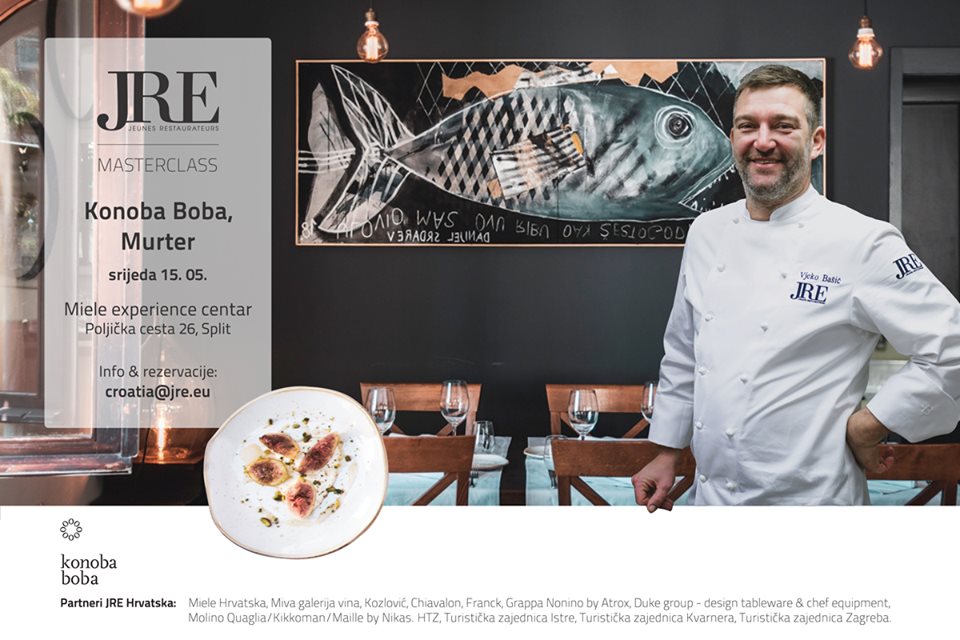
Now, if you aren’t familiar with Jeunes Restaurateurs, allow us to enlighten you.
JRE is an association of the most creative chefs from 16 countries in Europe. In Croatia, JRE boasts 14 restaurants, including San Rocco, Pergola, Marina, Zigante, Monte, Draga di Lovrana, Plavi podrum, Boškinac, Foša, Pelegrini, Dubravkin put, Villa Ariston, Konoba Boba, and Lešić Dimitri.
This association of the most creative gastronomy, founded in 1974, includes around 350 restaurants and 160 hotels in total, spread across 15 countries: Australia, Austria, Belgium, Croatia, Germany, France, Ireland, Italy, Luxembourg, the Netherlands, Poland, Slovenia, Spain, Switzerland, and the United Kingdom.
“JRE chefs combine extraordinary talent, a deep passion for cuisine, a love of local produce, and a strong sense of tradition. Their cooking expertise paired with the outstanding atmosphere of their restaurants offers a truly incredible experience.
JRE membership is open to young restaurateurs and chefs under the age of 42. However, when members reach the age of 50, they are awarded ‘honorary’ status and join JRE’s ‘Table d’Honneur’.
At JRE, everything revolves around sharing, encouraging and inspiring passion and talent for food. Our young chefs show great solidarity with each other and are delighted to exchange their cooking knowledge and expertise. As a guest at a JRE restaurant, there’s no doubt you will reap the benefits of this collective passion,” reads the JRE website, and after attending one of their masterclasses, this became even clearer.
The JRE masterclass held on Wednesday completed the association's masterclasses for the first part of the year. Namely, JRE held two at the Miele in Zagreb and two in Split. Each JRE masterclass is traditionally held at Miele, a high-end German manufacturer of domestic equipment and appliances.
The final masterclass for this half of the year featured chef Vjeko Bašić of Konoba Boba in Murter, a famous restaurant that prides themselves on traditional Kornati cuisine and locally sourced ingredients from the surrounding area. While most masterclasses max out at 8-9 guests, the demand for Vjeko’s culinary skills attracted around 12 curious visitors at Miele in Split.
Bašić began the masterclass with a welcome hors d'oeuvre; a perfect round of homemade (and gluten-free) tapioca bread, topped with fresh anchovies, osmugalj (which is best-translated in English as opposite-leaved saltwort), and dried olive oil, made with a combination of maltodextrin, olive oil, and salt.
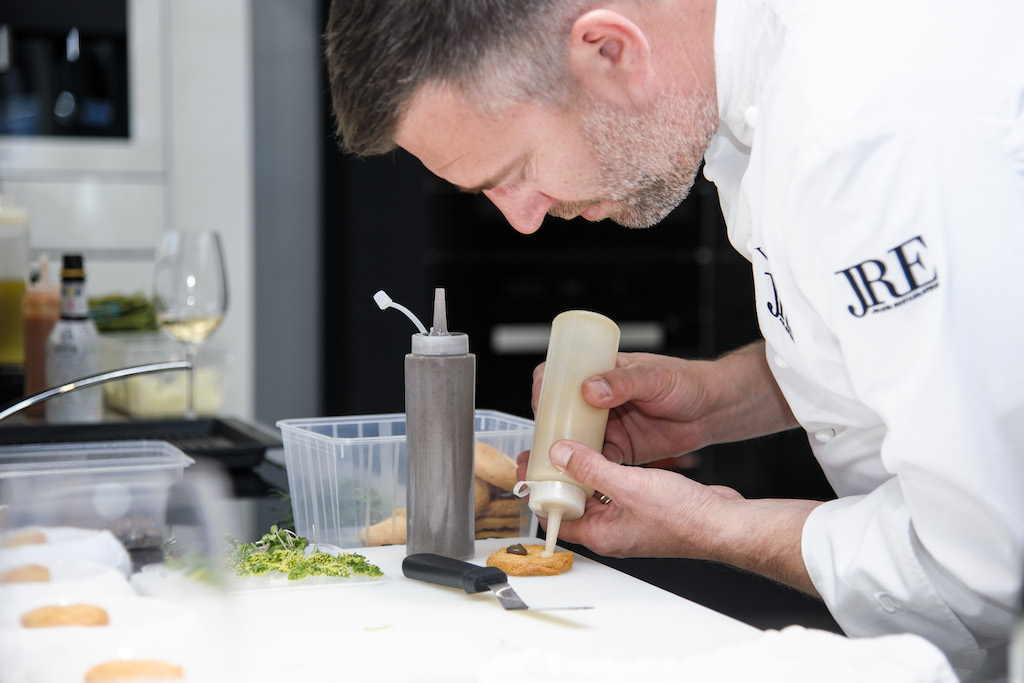
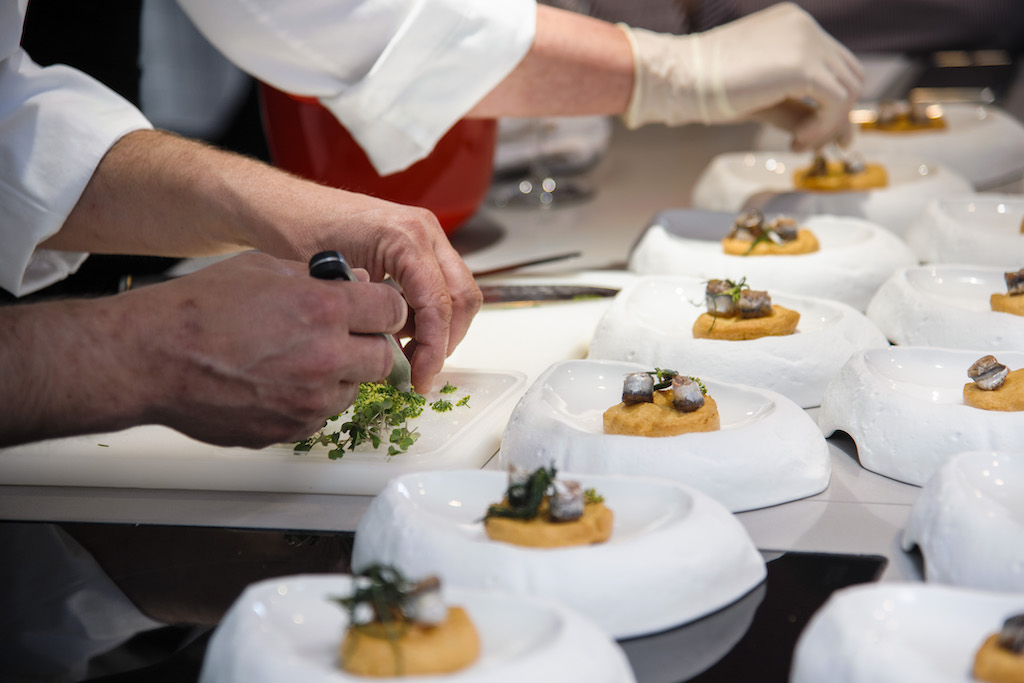
What rounded off the experience even more was that each course was paired with a different Croatian wine, and each serving plate was a unique Miele product.
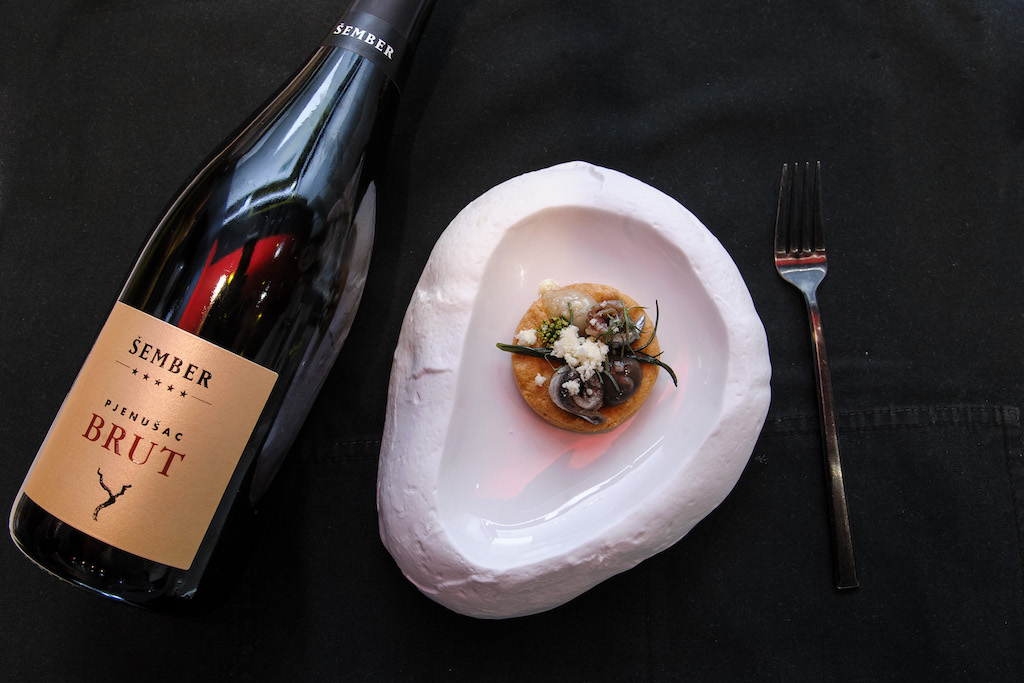
The first - a Pjenušac (sparkling wine) from the Šember winery in Jastrebarsko.
Up next, Bašić filleted a fresh Branzino (or European bass) into thin and delicate pieces for a carpaccio dressed with a lemon gel.
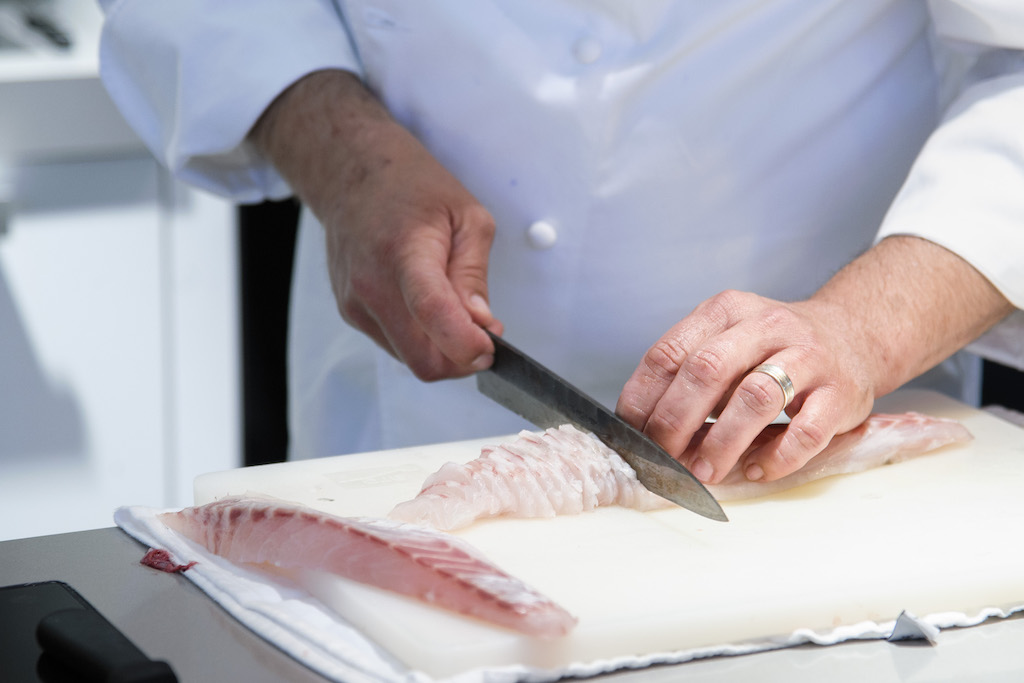
This course was paired with Blend No. 1 from Dvorac Belaj in Istria, a mix of chardonnay and malvazija.
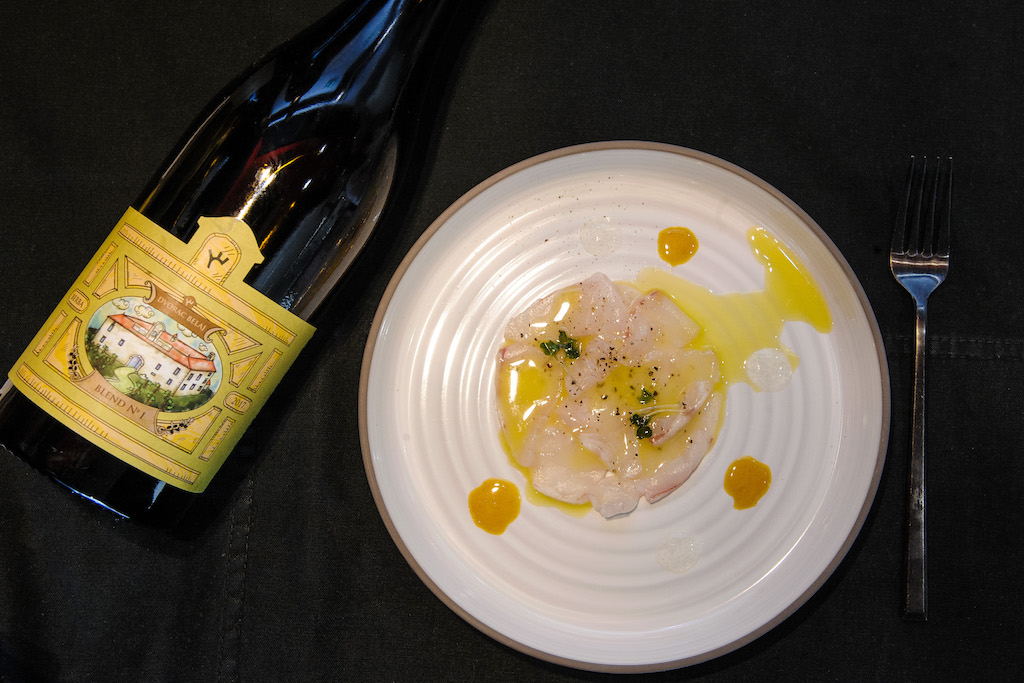
For the main course, Bašić constructed a risotto using the broth of boiled Branzino, the broth of fresh asparagus, which he joked was picked at Krka National Park, white wine, and a bisque made from the heads of scampi, tomatoes, and onions.
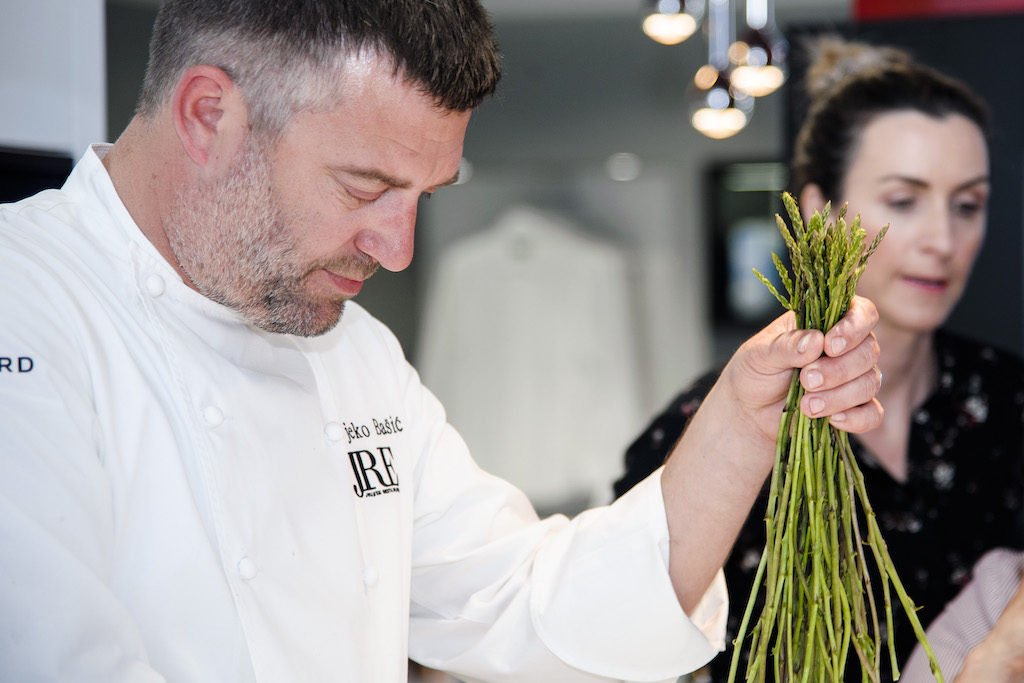
After it was tediously mixed for a solid half hour, the risotto was topped with quickly pan-fried scampi splashed with angostura bitters and an asparagus foam. The third wine pairing was a Sauvignon from the Galić winery in Slavonia.
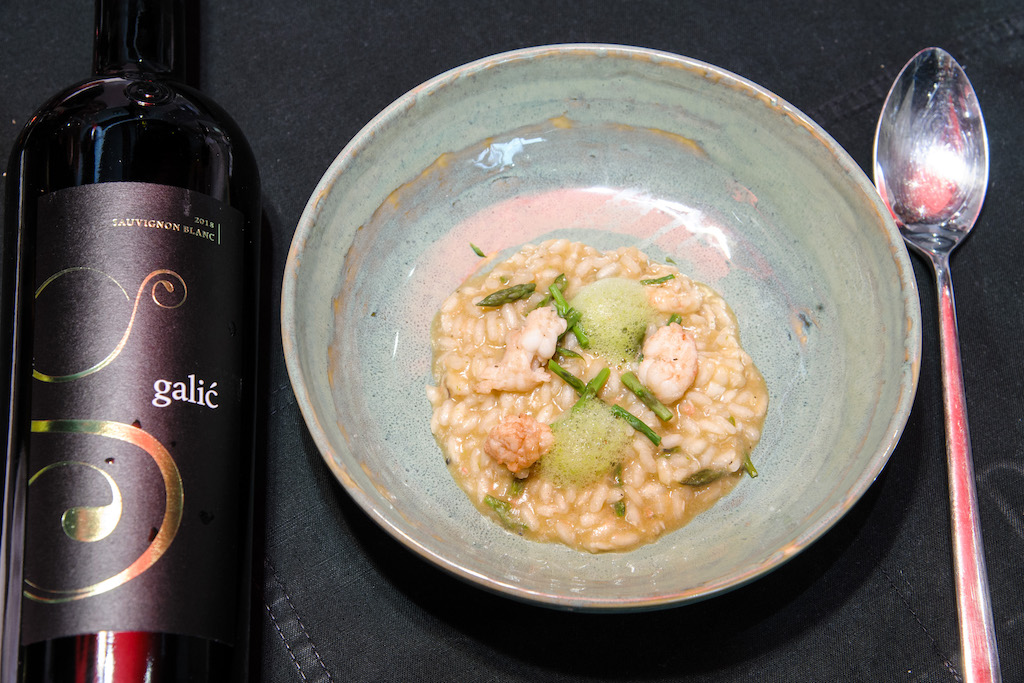
One unique takeaway from the masterclass experience was that JRE makes a limited blend of olive oil with the award-winning Chiavalon from Istria. You can find the oil in JRE restaurants, or, for example, at one of their masterclasses.
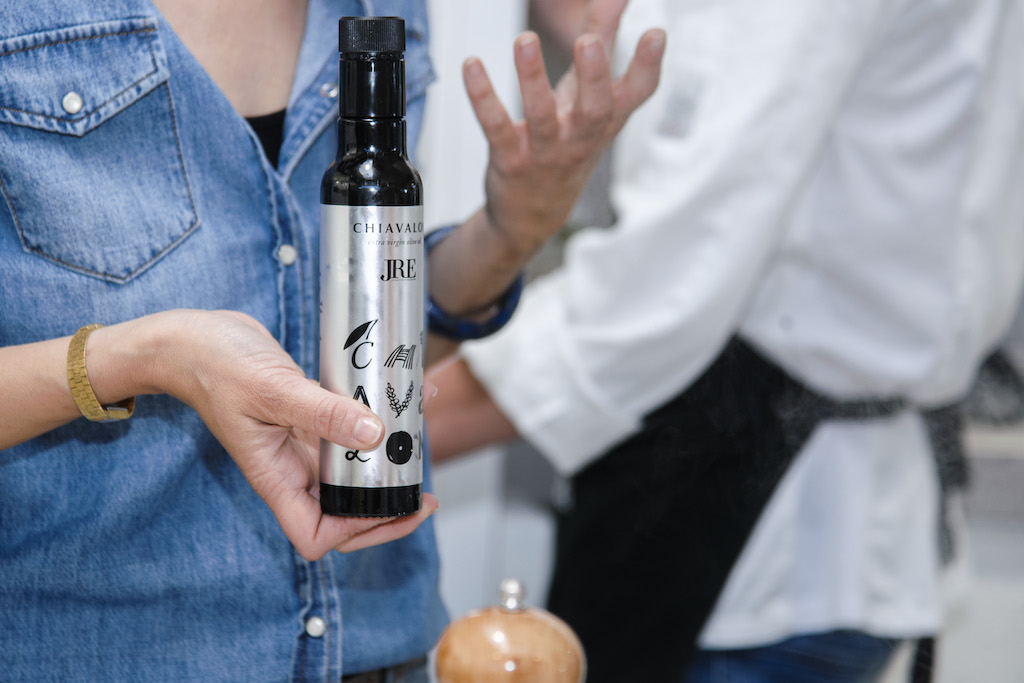
And for dessert? A simple yet decadent lemon cake decorated with lemon curd and almond flour crumble. We ended the evening with a Dolceto by Franc Arman in Istria.
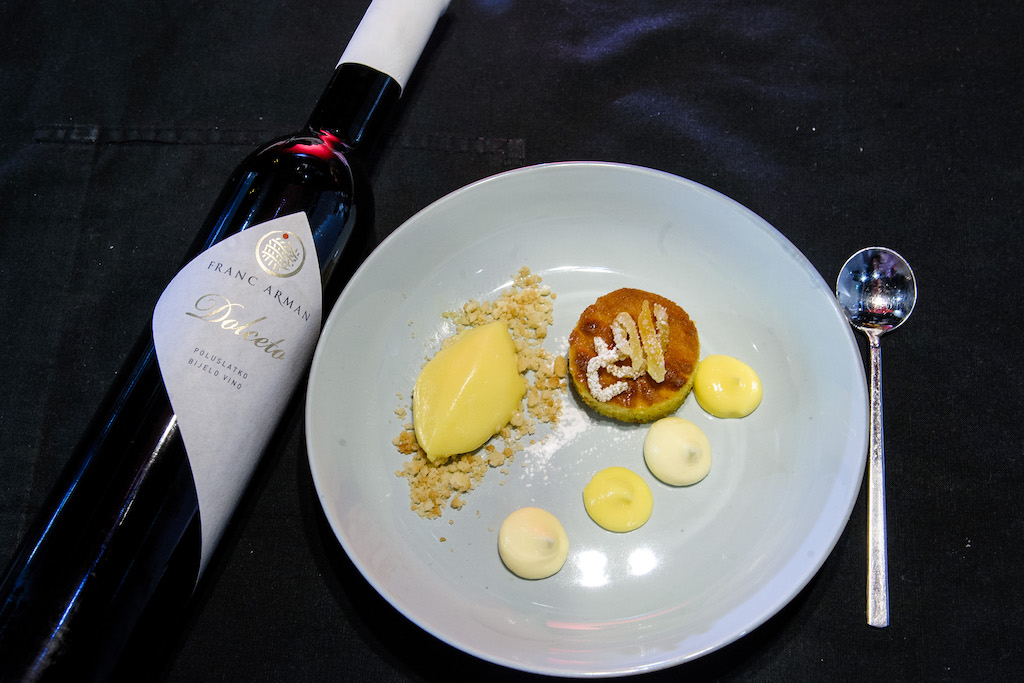
You can find all the photos from the masterclass below.
The JRE masterclasses are a way to bring the chef’s culinary talent and passion for food and local ingredients to an intimate setting of curious and like-minded people. The next four JRE masterclasses will pick up again in October with new JRE chefs. And stay tuned this summer, as JRE has something exciting cooking.
You can read more about the JRE association and sign up for the next masterclass by visiting their website and following them on Facebook.
To read more about lifestyle in Croatia, follow TCN’s dedicated page.
Croatia to Host Largest Lions Club Regatta in the World
The biggest Lions club regatta ever to be organized in the entire world will be taking place in Croatia in the days to come, April 24th until 27th around the island of Murter and Kornati.
28 foreign teams (over 50 teams total!), consisting of more than 500 participants in the regatta will set sail from the Hramina Marina on Murter and sail around Kornati archipelago, sending into the world the image of sportsmanship, companionship, empathy and helping one another. In addition to the excitement of the sporting competition, many other fun activities will be organized for the participants - such as the presentations of the dishes from the participants' home countries, costumed parties, presentations by the local restaurateurs, winemakers and family farms. Those are organized by the local communities and Murter Tourist Board.
This regatta will be a part of the tradition of the humanitarian "Sailing Against Drugs" action by the Lions Club, and in the past 21 years it has become a symbol of prevention of drug abuse and helping those in need. And with its over 500 participants, it will be the biggest sports event organized by the Lions Club International in 2019. The teams participating are arriving from Japan, Germany, Estonia, Albania, Sweden and many other European countries.
Lions Club International is one of the world's largest humanitarian organisations, with over a million and a half members, working under the slogan "We Serve", helping the blind, preventing youth violence, feeding the hungry and fight global epidemics such as diabetes. They are also very active in Croatia, and the local chapter has helped organise this year's Lions Club regatta in Croatia.
Hero of the Lateen Sails, Željko Jerat, Passed Away
On Monday 22nd April 2019, sad news spread along the coast with Jugo that Željko Jerat, the man who spearheaded the revival of the Lateen sails and gave so much to his community and the sea, passed away.
Željko Jerat was viewed as a visionary and leader by many. When most move away to study and never return, Željko returned from studying engineering in Zagreb, back to his “malo misto” (small place) of Murter. For the past two decades, it is from here that Željko revived the story of the Lateen Sails and played a vital role in preserving the maritime traditions in Murter and surrounding areas.
More than two decades ago, Dr. Vladimir Skračić had the idea that a regatta should be held alongside the anniversary of the Patron Saint Michael, to recognise the traditional sailing vessels which symbolised the life of Murter, and preserve the heritage of the region. This idea grew to reality, thanks to a team of enthusiasts spearheaded by Željko Jerat.
At that time, there were only three boats with Lateen sails on Murter, but thanks to a push from Jerat and others, four more traditional boats were restored just in time, so there were seven boats for the first “Latinsko Idro” (Lateen Sails Regatta). In time, this event has grown to a point where it now features 77 boats, not only from Murter, but also from Krk, Rab and Vis. This project united people from all across the Adriatic to restore these boats and keep a piece of priceless island history alive.
In an article by Sibenski Dalmacija, Jordanka Grubač described Jerat as a man with “seemingly limitless energy, infinite actions, endless devotion and loyalty to traditions and the sea… a man with exceptional organisational skills, a generous spirit, honesty and unbounded enthusiasm, right ‘til his end”.
“Every house in Vrulje which did not have a boat, knew that the olives would make it to the press in Murter if Željko was there with his leut. There was no sea nor cargo that Željko and “Jaruh” couldn’t do. And certainly, no lateen sail regatta that they couldn’t win.”
He held many prestigious titles in his time, founded one of the first charters in the region, which created many jobs for Murter locals, he was Head of the Croatian Charter Association, head of the Murter Tourist Board and of course, president of the Latinkso Idro Association – which has kept the story of the Lateen Sails alive for 21 years.
Željko Jerat was truly a character of the sea and man of the people, who will be sorely missed by the entire community.
In 2017, in an interview with Slobodna Dalmacija, when asked about the future of the regatta, Jerat said the same question needs to be posed to the public, the local authorities and the state institutions:
“How much do we actually care and are we ready for the next step?”
We wrote a post about whether Croatia should brand its traditional boats and regattas like they do in Sète, France – an event and manifestation which attracts close to half a million guests over Easter. Two years later, and not much has been done but hardly surprising considering the Croatian Tourism Board can’t even use Game of Thrones to their advantage.
If anything, I wouldn’t mind if Croatia didn’t brand itself as Game of Thrones country, but rather cherished, revived and promoted the incredible traditions and heritage that it has – like the story of the Lateen Sails. Maritime traditions and shipbuilding were a huge part of Dalmatia’s history. The Betina Museum in Murter, with its restored Gajeta and interactive and educational programs is a testament to this, but the “Latinsko Idro” (Lateen Sails Regatta), is something else – a living testament, history in motion, something to be seen, felt and experienced. Croatia has men like Željko Jerat to thank for this and should be doing more with this.
We know his spirit will live on in those who knew him, and can only hope his work and passion will not be lost, but rather continued and pushed forward by the next generation. The country at large could take inspiration from Željko Jerat and this story.
Mirno More Željko.
For more sailing news, you can follow our dedicated page Total Croatia Sailing, and find us on Facebook.
Zagreb Veterinary Students to Learn About Marine Life on Murter
As Morski writes on the 28th of March, 2019, this weekend, the island of Murter will host the first of two sets of field work of Zagreb veterinary students within the "Blue Project - Contribution to the development of the DKU Program at VFZS" project, carried out by the Argonaut association in partnership with the Faculty of Veterinary Medicine of the University of Zagreb, as well as the Pula Marine Education Centre.
The implementation of the project started back in April 2018, and the purpose of the project is to give the Zagreb veterinary students a chance to engage in socially beneficial marine environment conservation projects. Through the projects within the classes, and in cooperation with various civil society organisations, students will learn to properly identify the needs of the community and through the courses they undertake, develop potential solutions - projects that will see them engaged in the local community, according to a report from SibenikIN.
Within this concrete project, the topics that are likely among the most interesting to the Zagreb veterinary students will be the methods and ways of monitoring populations and providing treatment to the Adriatic's protected marine animals, such as sea turtles and dolphins.
In addition to Murter, students will also visit Pula and the Marine Education Center at the Pula Aquarium in mid-April this year.
Students will develop their projects through selected mentoring programs which include but aren't limited to visiting habitats during the winter months and learning how to properly aid a sea turtle who has become too cold, learning about the friendly behaviour of sea turtles and dolphins, what to do when coming across a sick or injured dolphin or sea turtle, and what the procedure is should a dead dolphin or sea turtle be discovered.
At the workshop in Murter, the thematic workshop will focus on dolphins and students will be educated on the development of monitoring protocols, recording the occurrence of protected marine animals - dates, times, geographical positions, the number of animals, their ages, their conditions and the level of potential human impact (maritime traffic, tourism and fishing), as well as the basics of photographing these types of protected marine species.
The project aimed at the Zagreb veterinary students and their further education will go on for eighteen months, more specifically until October 2019, and is co-financed by the European Social Fund (ESF) in the amount of 854,018,21 kuna, with a total value of 1,004,727.31 kuna. The project leader is the Argonaut association from Murter, and the partners of the project are the Faculty of Veterinary Medicine of the University of Zagreb and the Pula Marine Centre. The project is being implemented in the area of Šibenik-Knin County, Zagrebačka, and Istria County.
Make sure to follow our dedicated lifestyle page for much more.
Get to Know Sailing Club Žal, Oldest Sports Organization on Murter
How much do you know about the oldest sports organization on Murter?
Britain, Sweden, Germany, Slovakia... European Ambassadors to Clean Murter Seabed!
Ambassadors to Croatia from Europe and Canada are set to take their diplomacy to the very bottom, of the sea, that is.
Best European Museum of the Year, in Croatia: Betina Museum of Wooden Shipbuilding!
May 14, 2018 - Splendid news from Murter island: the Museum of Wooden Shipbuilding in Betina town now has a major award to boast!


